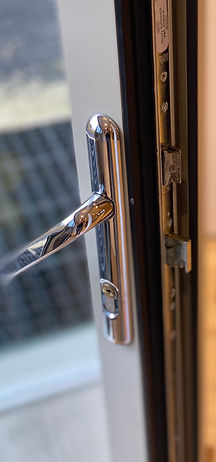Here at PSPS Locksmiths we can replace the multi-point lock on almost any uPVC doors without you needing to replace the door itself.
Below is a detailed explaination of what you can do to prevent any failures or diagnose a failure.
Common signs a uPVC may be about to fail include:
-
Key sticking in the lock.
-
Loose or limp door handles
-
Door handles being stiff to operate.
-
Handle lifts up, but the key won’t turn.
-
You can push the top or bottom of the door in from the outside when the door is locked.
-
The door won’t stay shut or springs open again when you close it.
Over time, the locking mechanisms (MPLs) in uPVC doors can wear out. When they start to become stiff or don’t operate the first time, this is usually a warning sign that the central part is wearing due to a miss aligned door/mech.
Left unpaired this can result in the mechanism jamming leaving you unable to lock the door, or even worse locked out.

How to check for problems with locks on uPVC doors:
-
Gently push the door shut. The door should push and latch shut easily without having to slam it or apply a lot of pressure.
-
Whilst the door is shut, check that it doesn’t move in the frame. From the outside, check that the top and bottom of the door don’t move whilst locked (be careful not to get locked out).
-
Lift the handle to lock the door. Check if there is any resistance. If you need to push hard, the handle appears to stick or doesn’t move smoothly, it is likely that one or more of the bolts or rollers is out of alignment with the frame (or other door).
-
Check the key goes into the lock smoothly, and turns without sticking or encountering resistance.
If you have already tried the maintenance steps to the right, it is likely the lock needs servicing. We recommend doing this at the first sign of a problem.
uPVC door lock maintenance tips:
-
Oil the moving parts (bolts, hooks, rollers etc) of the locking mechanism on the side of the door with spray oil (we recommend 3in1 or GT85 rather than WD40). Move the locking handle up and down whilst the door is open to help the oil work into the mechanism. Wipe away any excess oil with kitchen roll or a rag.
-
Spray a little oil into the keyhole on both the inside and outside. Insert/remove the key and turn it a few times to ensure the oil makes its way into the lock. Be careful the first few times you use the lock after this, as the key will have oil/dirt on it.
-
Carefully apply a little oil to the joint at the back of the handle, where it meets the backplate.
-
You should also oil the hinges, again taking care to remove any excess oil.
Try the checks on the left hand side, if the door doesn’t close or lock smoothly, give Mike or locksmith a call.

